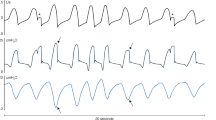Abstract
Beginning 7 h after death, a datalogger was used to measure the temperature in the external auditory canal of an adult male body placed in a refrigerated room. The sequence of measured values approximated a single exponential function with a correlation coefficient of 0.998475. This suggests that the starting time of body cooling in the refrigerated room under constant temperature can be calculated with less error using any two data points recorded by the datalogger. However, the results of such calculations varied widely and longer postmortem intervals demonstrated greater calculation errors. Periodic errors also appeared. Mathematical simulations showed that this variation was caused by rounding errors, which represent the difference between the thermometer readings and the true temperature. The resolution of the thermometer was 0.1°C, a normal specification; however, even this led to noticeable rounding errors. Therefore, significant errors may influence postmortem interval estimations using other body temperatures. When body temperatures are used to determine the time of death, a method that minimizes rounding errors should be considered.





Similar content being viewed by others
Notes
The error patterns in Figs. 1a, 2a,b, and d are characterized as the succession of the plot groups shaped “\”. The sizes of these groups are expanded. In this article, the distance from the upper-left point to the lower-right point along the transverse axis is defined as the cycle length and along the vertical axis as the error range (amplitude).
References
James WRL, Knight B (1965) Errors in estimating the time since death. Med Sci Law 5:111–116
Kil’diushov EM (2000) Thermometry of cadavers. Sud Med Ekspert 43:3–5
Henssge C (2002) Accuracy of calculated time since death. In: Knight B (ed) The estimation of the time since death in the early postmortem period, 2nd edn. Arnold, London, pp 96–100
Henssge C, Beckmann ER, Wischhusen F, Brinkmann B (1984) Determination of the time of death by measurement of central brain temperature. Z Rechtsmed 93:1–22
Henssge C (1979) Precision of estimating the time of death by mathematical expression of rectal body cooling. Z Rechtsmed 83:49–67
Mall G, Eisenmenger W (2005) Estimation of time since death by heat-flow finite-element model. Part I: method, model, calibration and validation. Leg Med (Tokyo) 7:1–14
Mall G, Eisenmenger W (2005) Estimation of time since death by heat-flow finite-element model part II: application to non-standard cooling conditions and preliminary results in practical casework. Leg Med (Tokyo) 7:69–80
Mall G, Eckl M, Sinicina I, Peschel O, Hubig M (2005) Temperature-based death time estimation with only partially known environmental conditions. Int J Legal Med 119:185–194
Henssge C, Althaus L, Bolt J, Freislederer A, Haffner HT, Henssge CA, Hoppe B, Schneider V (2000) Experiences with a compound method for estimating the time since death. I. Rectal temperature nomogram for time since death. Int J Legal Med 113:303–319
Henssge C, Madea B (2004) Estimation of the time since death in the early post-mortem period. Forensic Sci Int 144:167–175
Nokes L (2002) Double exponential models. In: Knight B (ed) The estimation of the time since death in the early postmortem period, 2nd edn. Arnold, London, pp 17–18
Marshall TK, Hoare FE (1962) Estimating the time of death. The rectal cooling after death and its mathematical expression. J Forensic Sci 7:56–81
Bendat JS (1986) Random data analysis and measurement procedures, 2nd edn. Wiley-Interscience, New York, pp 99–106
Soumori S, Sato T (2004) Statistics and chemometrics for analytical chemistry, 2nd edn. Kyoritsu, Tokyo, p 4
Parker SP (ed) (2003) McGraw-Hill dictionary of scientific and technical terms. McGraw-Hill, New York, p 13
Japanese Standard Association (ed) (2002) Quality control-2002. JIS, Tokyo
Baccino E, De Saint Martin L, Schuliar Y et al (1996) Outer ear temperature and time of death. Forensic Sci Int 83:133–146
Al-Alousi LM (2002) A study of the shape of the post-mortem cooling curve in 117 forensic cases. Forensic Sci Int 125:237–244
Hooft P, van de Voorde H (1989) The role of intestinal bacterial heat production in confounding postmortem temperature measurements. Z Rechtsmed 102:331–336
Nokes LD, Hicks B, Knight BH (1985) The post-mortem temperature plateau—fact or fiction? Med Sci Law 25:263–264
Shapiro HA (1965) The post-mortem temperature plateau. J Forensic Med 12:137–141
Hutchins GM (1985) Body temperature is elevated in the early postmortem period. Hum Pathol 16:560–561
Nokes L (2002) Temperature measurement. In: Knight B (ed) The estimation of the time since death in the early postmortem period, 2nd edn. Arnold, London pp 23–25
Author information
Authors and Affiliations
Corresponding author
Rights and permissions
About this article
Cite this article
Kanawaku, Y., Kanetake, J., Komiya, A. et al. Effects of rounding errors on postmortem temperature measurements caused by thermometer resolution. Int J Legal Med 121, 267–273 (2007). https://doi.org/10.1007/s00414-006-0088-8
Received:
Accepted:
Published:
Issue Date:
DOI: https://doi.org/10.1007/s00414-006-0088-8




